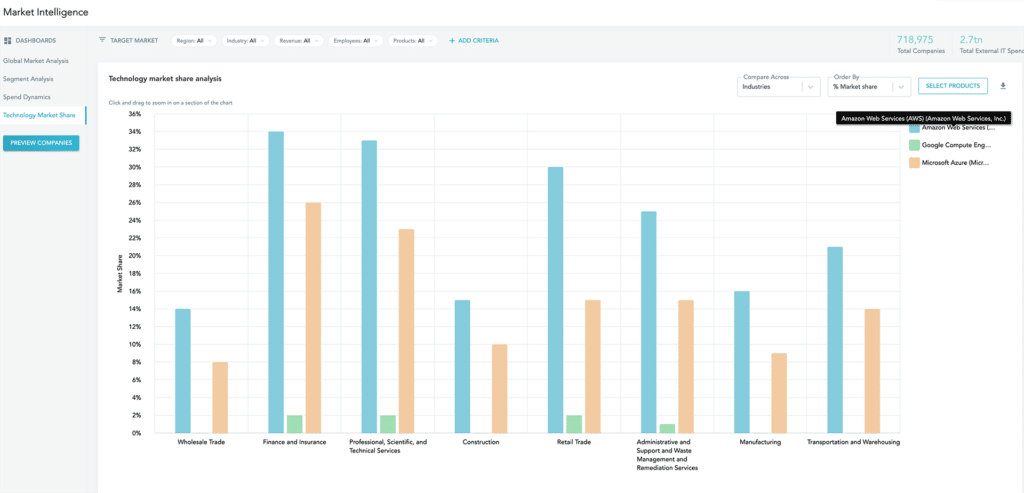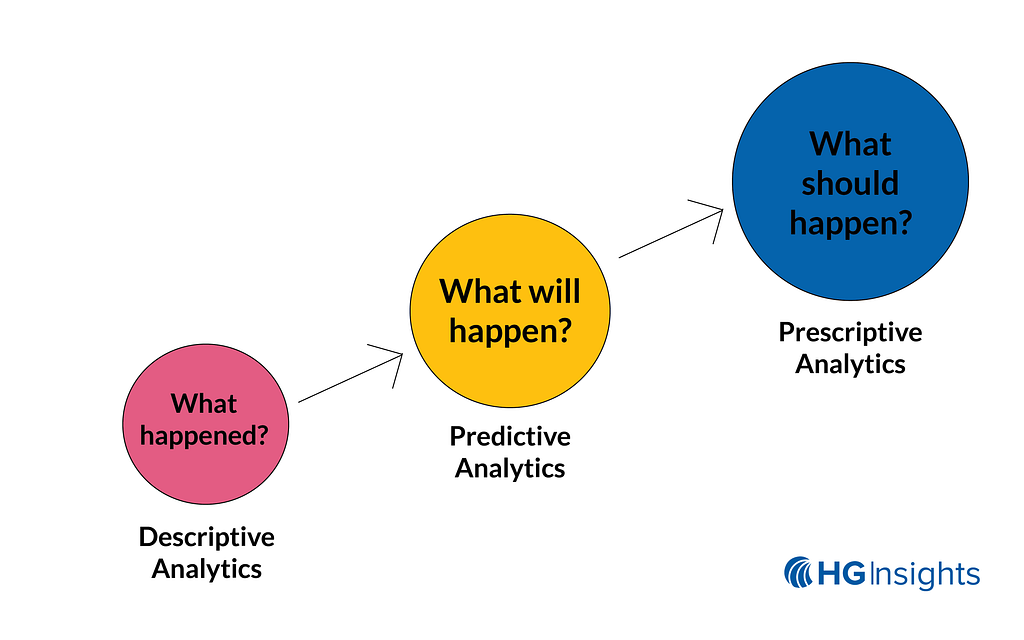
5 Insights From the Cutting Edge of Data Science
Last Updated on August 10, 2021 by Editorial Team
Author(s): Robert Fox
Data Science

In my 25 years of commercial software and engineering experience, I’ve led teams at industry-leading organizations like MuleSoft (now Salesforce) and Liaison Technologies (now OpenText).
And I’ve seen the industry make enormous progress.
Now, as the CTO of HG Insights, I get to work on the cutting edge of data science. I want to share my insights from a recent interview about data and insights, and how having patents pending on unique technologies is a surefire way to continue dominating the intelligence sector for years to come.
1. Rob, in 2021, we have more data than we know what to do with. 99.5% of collected data remains unused — which means that 0.5% of data is actionable insights. How does data become insights, and what makes insights actionable?
Turning data into actionable insights is impossible for most businesses because they lack the infrastructure, expertise, focus, and turn the right data into actionable insights. Think about it like this:
We all need fuel to run our cars, but we don’t typically manufacture our own fuel. Insights are fuel for the business.
What makes our work unique is the amount of data we collect and the amount we actually throw away. Our process cleans, dedupes, and prepares billions of documents each month, and we collect even more digital content to figure out what may have actionable insights before we mine it. The reduction process is every bit as important as the mining and extraction.
The quality of our insights is also unique. While we mine billions of customer-consumable data points each month, not everything makes the cut. We hold a very high bar for the quality of these empirical data points — the precision in our data is 90% or higher. At the end of the day, it’s only an insight if it generates ROI for our customers. If the quality is low then we cannot drive customer value. This is why we focus on the quality of insights over quantity.
We turn data into insights by amassing an extraordinary amount of data, boil it down and transform it in a way that can be readily consumed by a customer through our products and services. Our insights are tailored to drive customer value and enable them to maximize ROI with as little effort as possible.
We help customers sift through the vast noise of data to focus on the right signals.
2. As CTO, how do you keep innovating HG Insights’ solutions to keep up with the emerging needs of customers and the pace of growth in the industry?
I start by asking questions like: “Why does your business exist?” Or, “What question do you wish you had the answer to that would make your business wildly successful?” That gives me all the fuel I need to go figure out how to help a customer with their individual needs.
The truth is, customers and the solutions they deploy are getting more and more data sophisticated. When HG Insights began, we focused on providing our customers with details on which technologies a company used. This was our “Ridiculously Unfair Advantage,” and we helped companies drive more effective sales and marketing programs to increase conversions. We were pioneers at providing this kind of insight at scale — and we still are, because we are relentless in finding new ways to provide customers the answers to increasingly sophisticated questions.
On a bigger level, we invest in innovation. A couple of years ago, CEO Elizabeth Cholawsky and I started a new initiative, “CoreIP,” to reinvest in innovation. Our explicit goals are to improve our data and insights and bring new insights to the market. As part of this initiative, we launched a patent program to help foster innovative ideas and we have already filed four patents, with several more in the queue.
We believe we have a duty to continue innovating and leading in this space, all while maintaining our promise of quality.

3. Can you tell us more about the patent program, the four patents already filed, and how they position you in the technology intelligence sector?
We introduced the Inventions Program as a way to foster a collaborative environment throughout the company. Teams are encouraged to engage with all our products and give us ideas on how to improve and expand them — or propose something entirely new.
Out of that, we have already filed four new patents. One example of a recent patent is a new and novel way of doing named-entity resolution in the text to help us better disambiguate and discern meaning. Here’s an example: imagine you have a document that mentions the word “Google”. Now we’re left with the question: does this document reference Google as the entire company, or just a specific product? Is it a short-hand for Google Cloud Platform (GCP)? Or is it referring to Google Workspace (formerly G Suite)? In our world, context means everything.
Tools like this drive up precision and overall coverage of our data, which lead to increased ROI for our customers. This is just one of the many new patents and plans we have to leverage our unparalleled data.
“I always say a prediction in business is worthless until it results in an outcome.”
4. What are some potential applications/use cases of data that we might not be aware of? Are there other industries that would benefit from your data?
We sit on a goldmine of information. Because we have data and insights derived from thousands of technologies across millions of businesses, we frequently combine pieces to create something new. For example, we match insights we’ve already mined with new data points or experimental analyses to create new, actionable insights.
From a general perspective, this has led to two kinds of inventions:
- Novel techniques or machinery to mine data: For example, a patent on a new technique in named entity resolution
- Novel insights from the mined data: For example, a patent on a machine learning model that predicts technology purchase behavior
We experiment with all kinds of new applications of our insights constantly — everything from trying to determine technology adoption down to the department and location level over time, contextualizing intent data, profiling reseller/consultant loyalty to a particular vendor or technology, to identifying emerging/breakout technology vendors and products.
This means helping customers sift through the vast noise of data to focus on the right signals. And even though we primarily focus on technology in the B2B vendor space, everything we build is generic enough to be applied to other industries such as financial services, healthcare, and more.
5. Finally, “predictive” is a word frequently thrown around the data/big data space, how established are you in predictive analytics?
If nobody believes your prediction or understands why it was made, you’ve got a problem.
This is the thinking behind cognitive AI. I am a big proponent of cognitive AI, not just in making predictions but in showing the customer why the prediction was made. To illustrate my point:
One of the things we typically do for customers is to create a technology-based propensity model or Ideal Customer Profile. This is part of HG Insights’ unique value. But we don’t just tell them which customers they should target, we show them why. When you show the customers why a prediction was made you create credibility. There is too much black box fatigue out there. Connecting the human brain with AI prediction is at the heart of cognitive AI.

Thanks for reading!
About Me

I have over twenty-five years of commercial software and engineering experience, strong analytical skills, and a broad range of general industry and business knowledge. I’ve led engineering teams at industry-leading organizations like MuleSoft (now Salesforce) and Liaison Technologies (now OpenText).
I specialize in all things data, including analytics, data science, integration, management, security, API management with domain expertise in and around B2B, EAI, Cloud, and Big Data.
5 Insights From the Cutting Edge of Data Science was originally published in Towards AI on Medium, where people are continuing the conversation by highlighting and responding to this story.
Published via Towards AI
Take our 90+ lesson From Beginner to Advanced LLM Developer Certification: From choosing a project to deploying a working product this is the most comprehensive and practical LLM course out there!
Towards AI has published Building LLMs for Production—our 470+ page guide to mastering LLMs with practical projects and expert insights!

Discover Your Dream AI Career at Towards AI Jobs
Towards AI has built a jobs board tailored specifically to Machine Learning and Data Science Jobs and Skills. Our software searches for live AI jobs each hour, labels and categorises them and makes them easily searchable. Explore over 40,000 live jobs today with Towards AI Jobs!
Note: Content contains the views of the contributing authors and not Towards AI.















